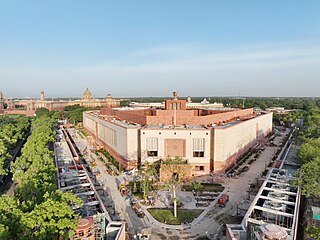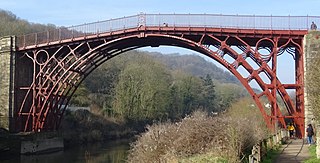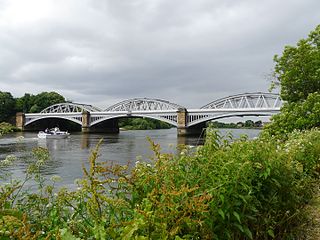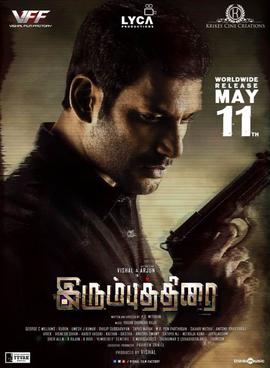
A suspension bridge is a type of bridge in which the deck is hung below suspension cables on vertical suspenders. The first modern examples of this type of bridge were built in the early 1800s. Simple suspension bridges, which lack vertical suspenders, have a long history in many mountainous parts of the world.

The Brooklyn Bridge is a hybrid cable-stayed/suspension bridge in New York City, spanning the East River between the boroughs of Manhattan and Brooklyn. Opened on May 24, 1883, the Brooklyn Bridge was the first fixed crossing of the East River. It was also the longest suspension bridge in the world at the time of its opening, with a main span of 1,595.5 feet (486.3 m) and a deck 127 ft (38.7 m) above mean high water. The span was originally called the New York and Brooklyn Bridge or the East River Bridge but was officially renamed the Brooklyn Bridge in 1915.

New Delhi is the capital of India and a part of the National Capital Territory of Delhi (NCT). New Delhi is the seat of all three branches of the Government of India, hosting the Rashtrapati Bhavan, Sansad Bhavan, and the Supreme Court. New Delhi is a municipality within the NCT, administered by the NDMC, which covers mostly Lutyens' Delhi and a few adjacent areas. The municipal area is part of a larger administrative district, the New Delhi district.

The Tay Bridge carries the railway across the Firth of Tay in Scotland between Dundee and the suburb of Wormit in Fife. Its span is 2.75 miles. It is the second bridge to occupy the site.

John Rennie FRSE FRS was a Scottish civil engineer who designed many bridges, canals, docks and warehouses, and a pioneer in the use of structural cast-iron.

The Pontcysyllte Aqueduct is a navigable aqueduct that carries the Llangollen Canal across the River Dee in the Vale of Llangollen in northeast Wales.

Chelsea Bridge is a bridge over the River Thames in west London, connecting Chelsea on the north bank to Battersea on the south bank, and split between the City of Westminster, the London Borough of Wandsworth and the Royal Borough of Kensington and Chelsea. There have been two Chelsea Bridges, on the site of what was an ancient ford.

The Montgomery Canal, known colloquially as "The Monty", is a partially restored canal in eastern Powys and northwest Shropshire. The canal runs 33 miles (53 km) from the Llangollen Canal at Frankton Junction to Newtown via Llanymynech and Welshpool and crosses the England–Wales border.

Thrippunithura, also spelled Tripunithura,, is a municipality in Ernakulam district in the state of Kerala, India, located about 6 km (4 mi) east of the city centre. A prominent historical region, Trippunithura was the capital of the erstwhile Kingdom of Cochin. The Hill Palace situated in Tripunithura was the palace of Maharaja of Cochin, the ruler of Kingdom of Cochin. Thrippunithura is known for its rich culture which includes the annual Vrishchikotsavam festival that takes place at the Sree Poornathrayeesa Temple.

Navigable aqueducts are bridge structures that carry navigable waterway canals over other rivers, valleys, railways or roads. They are primarily distinguished by their size, carrying a larger cross-section of water than most water-supply aqueducts. Roman aqueducts were used to transport water and were created in Ancient Rome. The 662-metre (2,172 ft) long steel Briare aqueduct carrying the Canal latéral à la Loire over the River Loire was built in 1896. It was ranked as the longest navigable aqueduct in the world for more than a century, until the Magdeburg Water Bridge in Germany took the title in the early 21st century.

The Iron Bridge is a cast iron arch bridge that crosses the River Severn in Shropshire, England. Opened in 1781, it was the first major bridge in the world to be made of cast iron. Its success inspired the widespread use of cast iron as a structural material, and today the bridge is celebrated as a symbol of the Industrial Revolution.

Barnes Railway Bridge is a Grade II listed railway bridge in the London Borough of Richmond upon Thames and the London Borough of Hounslow. It crosses the River Thames in London in a northwest to southeast direction at Barnes. It carries the South Western Railway's Hounslow Loop Line, and lies between Barnes Bridge and Chiswick stations. It can also be crossed on foot, and is one of only three bridges in London to combine pedestrian and rail use; the others being Hungerford Bridge and Golden Jubilee Bridges and Fulham Railway Bridge.

Cast-iron architecture is the use of cast iron in buildings and objects, ranging from bridges and markets to warehouses, balconies and fences. Refinements developed during the Industrial Revolution in the late 18th century made cast iron relatively cheap and suitable for a range of uses, and by the mid-19th century it was common as a structural material, and particularly for elaborately patterned architectural elements such as fences and balconies, until it fell out of fashion after 1900 as a decorative material, and was replaced by modern steel and concrete for structural purposes.
Sahodaran Ayyappan Road, popularly known as S.A Road is one of the most important and the second main arterial road of CBD Kochi city ; it is supposed to be the busiest and most congested road in the city of Kochi, which run in east-west direction and the shortest road connecting the two main iconic junctions in the city. The road connects the MG Road in west with Vyttila Junction & Hub in east and continues further as Tripunithura Road that connects to Tripunithura, hence termed as the back bone road of Kochi.

Vignoles Bridge is a footbridge over the River Sherbourne in Spon End, a western suburb of Coventry in central England. It stands just west of the inner ring road in the middle of a housing estate, to where it was relocated in 1969. It was built in 1835 and originally spanned the Oxford Canal. The bridge is a single-span cast-iron arch and is a scheduled monument.

Meldon Viaduct is a disused railway viaduct crossing the West Okement River at Meldon, 2.5 miles (4.0 km) south-west of Okehampton, on the edge of Dartmoor in Devon, South West England. This truss bridge was constructed from wrought iron, instead of stone or brick arches. It opened in 1874 for a single track; in 1879 its width was doubled for a second track. Although regular services were withdrawn in 1968, the bridge was used for shunting by a local quarry. In the 1990s the remaining single track was removed.
There are many stories that describe the origin of the word Thripunithura. Some latter day Sanskrit enthusiasts ascribe the origin of the name to "Poorna Veda Puri" - the town of Vedas in its entirety. Another possible origin to name comes from the meaning "the land on the shores of Poorna river".

Irumbu Thirai is a 2018 Indian Tamil-language techno-thriller action film directed by debutant P. S. Mithran. The film stars Vishal, Arjun, and Samantha Ruth Prabhu, with Yuvan Shankar Raja composing the soundtrack. The film was produced by Vishal Film Factory, and the venture began production in October 2016. The narrative centers around an army officer, who starts hunting down a gang of hackers after they steal money from his bank account.

The Kuttippuram Bridge is a bridge that connects Kuttippuram with the Thavanur-Ponnani region in Malappuram district, Kerala, India. The Tirur and the Ponnani Taluks are separated by the river Bharathappuzha, which is also the second-longest river in Kerala. The bridge connects these two regions. It is a part of the National Highway 66 on the Kozhikode - Kochi route. It is one of the largest and oldest bridges built over the river Bharathappuzha, and plays a major role in connecting the Malabar region with the erstwhile Travancore-Cochin via road.
Venduruthy-Vikrant Bridge, also known as Venduruthy Bridge is a bridge in Kochi, Kerala, India. There are two bridges at present; one railway bridge and one road bridge, running parallel to each other, that connects the Ernakulam side of Kochi to the Willingdon Island. The old Venduruthy railway bridge was constructed in 1938 along with two parallel road bridges. The old railway bridge is one of the first bridges in India to be completely constructed from steel. It is a landmark in Kochi with historic significance as it played a major role in the transformation of Kochi into a major port city in India during the British era.

















